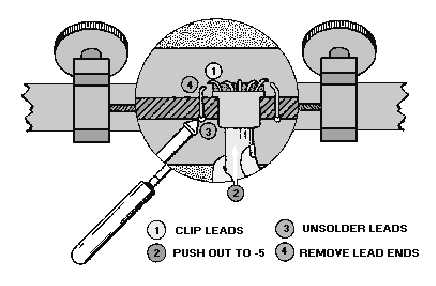3-29
Figure 3-20.—Imbedded TO removal.
The most critical part of replacing an imbedded TO is the lead formation. The leads are formed to
match the original part as closely as possible. Once the body and leads are seated, the leads can be
soldered and the board inspected.
REMOVAL AND REPLACEMENT OF FLAT PACKS
Up to this point, all of the components discussed have had through-the-board leads. In addition, the
removal and replacement of discrete components, DIPs, and TOs have been similar.
PLANAR-MOUNTED COMPONENTS (FLAT-PACKS)
Different techniques are used in the removal and replacement of flat packs and devices with on-the-
board terminations. Lap-flow solder joints require that the technician pay particular attention to
workmanship. Some of the standards of workmanship will be discussed later in this section.
Flat-Pack Removal
Prior to the removal of a flat pack, as with other ICs, a sketch should be prepared to identify the
proper positioning of the part. The conformal coating should be removed as required.
To remove the flat pack, the 2M technician carefully heats the leads and lifts them free with
tweezers. If the part is to be reused, special care is taken not to damage or bend the leads. The work area
around the component should then be thoroughly cleaned and prepared for the new part.
Flat-Pack Replacement
Flat packs attached to boards normally have formed and trimmed leads. Manufacturers form and trim
the leads in one operation with a combination die. However, most replacement flat packs are received in a
protective holder (figure 3-21) and the leads must be formed and trimmed by hand. Cost prevents
equipping the repair station with the variety of tools and dies to form leads because of the variety of
component configurations.

